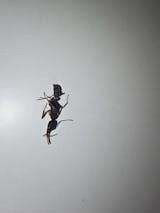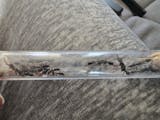Leaf cutter posture
Which leaf cutters should I choose?
Keeping leafcutters is not as difficult as most of you think. First of all, you have to decide on the question of space. If you don't have a lot of space, an Acromyrmex would be better suited, such as Acromyrmex octospinosus. They reach a maximum colony size of around 20,000-30,000 individuals and around 8-10 liters of mushroom. If, on the other hand, you have a lot of space, you can keep an Atta, such as Atta sexdens, which can grow to several million when kept at home. You can control the size of their colony by always feeding them the same amount of leaves. I doubt whether this is species-appropriate and would therefore recommend that you look at what you have the space and time for. There are of course many other species that form smaller colonies, for example; you are welcome to look and read about them in our shop or at other shops.
Temperature & humidity?
In addition, most leaf cutters require an increased temperature to grow well, but this varies from species to species, so the only thing that helps is experimenting and observing.
Atta cephalotes, for example, only becomes truly active at around 25 degrees Celsius and begins to cut leaves. Atta sexdens, on the other hand, usually only needs about 21-24 degrees Celsius to be truly active. However, this depends on their origin and varies among most colonies, even within the same species. The only way to find out is to try it out and observe for yourself.
To better regulate and control the temperature, we recommend a thermo-hygrometer and a heat mat. The heat mat should not be placed under the mushroom tank, as this would damage the mushrooms. Instead, you can attach the heat mat to the side of the mushroom tank or to the lid of the mushroom tank. Be careful, though: cheap heat mats break quickly and heat too much or not at all.
To be able to regulate the humidity easily, we recommend Seramis. Simply put some dry and some moist Seramis in the mushroom tank so the ants can regulate it themselves. We also recommend moistening the substrate slightly (sand-loam is recommended). However, make sure that the mushroom has a neutral surface, ideally the floor of the mushroom tank or a small piece of Plexiglas. Since the mushroom should never come into contact with water, the substrate under the mushroom should be avoided. For smaller colonies, you should use a mushroom cover, e.g. place a small plastic bowl upside down over the mushroom. The plastic bowl should have a notch that acts as an entrance and exit and this should not be too big. The cover should be big enough to give the fungus space to grow. If the mushroom cover is completely filled with fungus, it would have to be changed. As soon as the mushroom is 1/3 of the mushroom tank full of fungus, a mushroom cover is usually not needed.
Feeding and care?
For small colonies, we recommend a water dispenser in the form of a drinker, for example. Leafcutters get all their nutrients from the leaves and from the fungus they grow. In smaller colonies, leaves do not need to be cut every day, as there are not enough workers to ensure they get enough nutrients and liquid. A drinker and the occasional drop of sugary water helps with this. You can also offer them fruit such as grapes, but fresh fruit should be used up or removed after 24 hours. As far as leaves go, we recommend offering fresh leaves 2-3 times a week, depending on the size of the colony, such as blackberry leaves, raspberry leaves, dandelion leaves, rose hip leaves, butterfly orchid leaves, and much more. Make sure the leaves are untreated, so avoid florists. We recommend getting leaves from your own garden or from nature. Avoid poisonous plants, but the ants usually know what is poisonous and what is harmless. Nevertheless, inform them before feeding. Rinse all leaves with water beforehand so they will be better accepted.
Attachment:
No expensive equipment is required; for a small colony of up to 100 workers, a plastic box measuring approximately 30x30 is sufficient. It is important to ensure that the mushroom waste is removed three times a week to prevent the risk of mold growth.
For larger colonies we recommend 3 separate areas, one as a waste basin, one as a mushroom basin (preferably in the middle of the waste and food basins) and one as a food basin.
The waste basin should always be dry and can be heated, which also protects against mold and only needs to be emptied every 1-2 weeks.
The mushroom tank should always have a humidity of over 95% and ideally without air holes.
The feeding bowl should have holes in the lid and can have slightly increased humidity and is used to offer leaves.
The three areas should be connected with a hose, for example, and adjusted to the colony size. For a colony size of 100-500 workers, walkways of 30-60 cm are sufficient. Atta colonies tend to prefer shorter walkways than Acromyrmex colonies.




